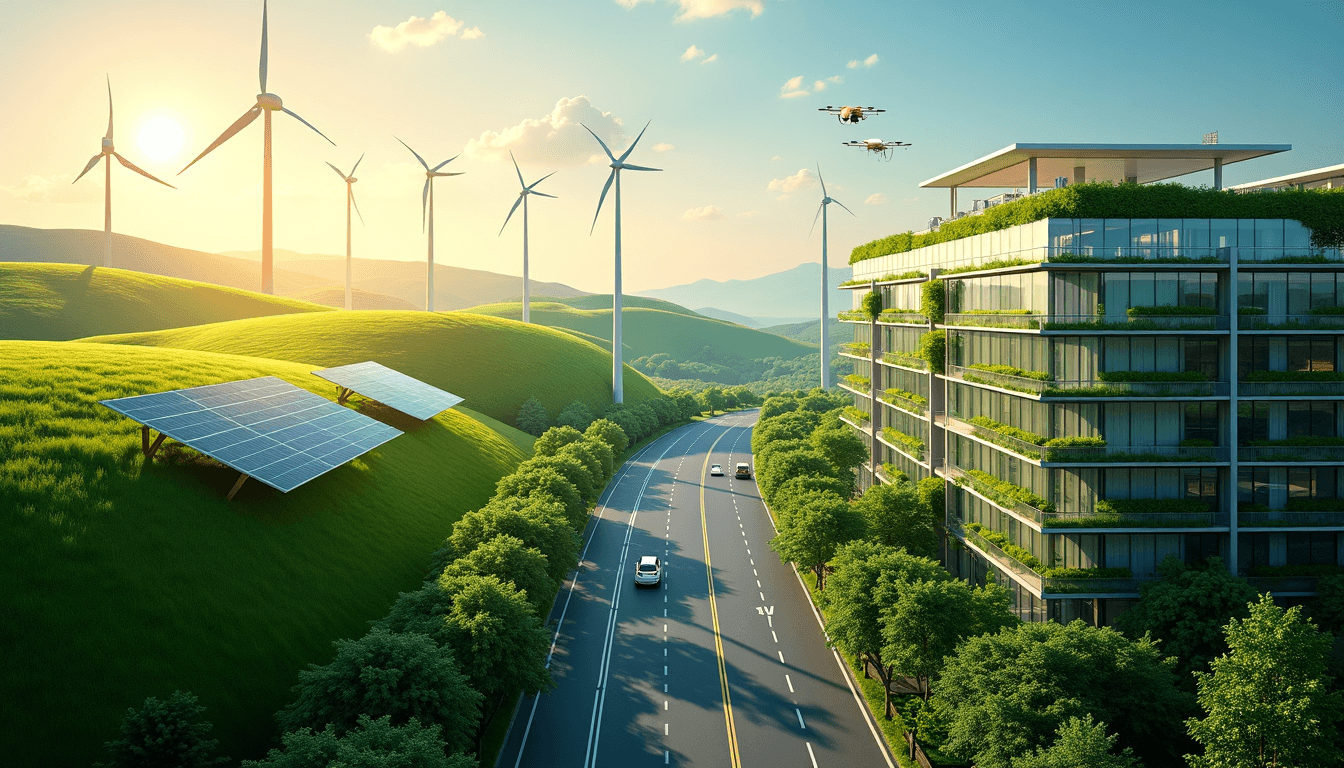Climate change and environmental degradation affect our planet more each day. This reality has made green technology pioneer innovation that offers promising solutions to our most pressing environmental challenges.
Environmental friendly technology has become a necessity rather than a luxury. Smart waste management solutions and renewable energy systems revolutionize our relationship with the environment. These innovations’ effects reach way beyond the reach and influence of what most people imagine. My experience tracking these developments confirms this fact.
This detailed piece will show how green technology shapes our future. We will look at breakthrough innovations, successful implementations, and these solutions’ remarkable ways to tackle our environmental challenges.
Understanding Modern Environmental Challenges
Our planet faces environmental challenges that need immediate action. Right now, we need 1.6 Earths just to keep up with our current lifestyle. This shows how unsustainable our consumption patterns have become.
Current environmental crisis points
The numbers behind our environmental crisis paint a stark picture. Here are some eye-opening statistics that reveal our challenges:
- Human actions have altered 75% of Earth’s land surface
- Human activities affect 66% of our ocean areas
- All but one of these marine fish stocks are fully exploited or depleted, reaching nearly 90%
- Land degradation affects about 3.2 billion people worldwide
Limitations of traditional solutions
Traditional approaches don’t work well enough anymore. Legal solutions and state policies don’t deal very well with climate change. Local initiatives matter but can’t reduce carbon emissions enough without federal backing. Environmental issues cross borders – what helps one area might not benefit that region directly.
Role of technological innovation
Green technology changes everything. It helps create new products and makes existing processes better by using less energy and creating fewer emissions. Recent developments show that technological innovation reshapes industrial processes, especially when we need to update and improve modern production systems.
Green tech innovations tackle several problems at once. To name just one example, see how countries improve their production while lowering carbon emissions. The results speak for themselves – studies show that eco-friendly technological innovation works better than traditional approaches to address climate challenges.
Revolutionary Green Technology Solutions
The latest breakthroughs in green technology have caught my attention. They’re changing how we think about sustainability. Let me tell you about some developments that are making waves.
Breakthrough sustainable innovations
A new way to turn waste wood into electricity stands out among recent advances. This development shows how we can be budget-friendly while completing the resource usage cycle. Scientists in biomanufacturing have made another leap forward. They’ve created blended sugars that don’t compete with food production.
Smart city technologies
Cities are getting smarter in ways you might not expect. Studies reveal that urban areas with multiple centers and scattered green spaces fight extreme heat better than traditional single-center designs. These developments in smart cities really get me excited:
- Strong infrastructure with IoT sensors for immediate monitoring
- Smart street lighting systems that cut energy usage by up to 70%
- Intelligent transportation networks that optimize traffic flow
Waste reduction systems
New waste management technologies are revolutionizing our cities. AI-based sorting systems have pushed recycling accuracy up to 95% in waste separation. European countries lead the charge with strict rules for the entire plastic value chain. Their approach to plastic waste management sets new standards.
These developments show great promise because they work. To name just one example, see Oregon State University’s hybrid electricity generator. It uses microbial fuel cells to turn wastewater into electricity. This shows how challenges can become opportunities.
Impact of Renewable Energy Technologies
The renewable energy sector’s progress amazes me. These technologies are becoming cheaper and more efficient. The numbers paint an exciting picture – solar and wind energy have grown beyond expectations, with the U.S. adding more than 121 GW of utility and small-scale solar capacity over the last several years – a remarkable 688% increase.
Solar and wind power advancements
Wind power has made huge strides. Wind turbines have evolved since the 1990s – their height increased from 30 meters to 90 meters and rotor diameter expanded from 30 meters to 125 meters. These improvements make wind power viable in new regions. Recent breakthroughs could revolutionize 80% more economically viable wind energy capacity in the U.S..
Energy storage solutions
Energy storage has become a game-changer in the market. Battery energy storage systems attracted investments exceeding $5 billion in 2022. Here’s what the data shows:
- Battery costs will drop 50-60% by 2030
- Utility-scale storage grows 29% annually
- New thermal storage technologies should reach 800 GWh of installed capacity by 2030
Grid modernization efforts
Our power grid’s transformation shows great promise. Traditional centralized systems are giving way to distributed models. Australia’s electricity generation capacity could see 45% coming from distributed energy resources by 2050. The future grid needs substantial investment – experts project spending up to $2 trillion on grid modernization by 2030 to maintain reliability.
Green Tech Implementation Success Stories
Green technology’s true strength shines through its effective implementation. Here are some remarkable success stories that show its practical effects.
Corporate adoption cases
Tesla’s state-of-the-art sustainable solutions stand out prominently. Their Nevada Gigafactory shows how green technology reshapes the scene in manufacturing. The facility runs completely on renewable energy and has achieved a 30% reduction in carbon emissions. 62% of Fortune 500 companies have adopted at least one green technology solution.
Government initiatives
The federal government shows steadfast dedication to green technology. The Federal Sustainability Plan sets bold targets that include achieving 100% carbon pollution-free electricity by 2030 and 100% zero-emission vehicle acquisitions by 2035. This plan goes beyond target-setting and creates a climate-focused workforce while advancing environmental justice.
Community-level projects
Community-level achievements tell a compelling story. The Clean Energy to Communities (C2C) program connects local governments and tribes with national laboratory experts to meet clean energy goals. 75% of clean energy investments from the Inflation Reduction Act have gone to congressional districts with below-average median incomes. The results are encouraging:
- Communities benefit directly through improved air quality monitoring
- Local projects generate new job opportunities
- Small-scale initiatives prove that green technology works at any level
These success stories prove that green technology extends beyond innovation. It delivers tangible changes that benefit our communities.
Conclusion
Green technology proves to be more than a promising solution – it’s the life-blood of our sustainable future. These state-of-the-art developments tackle our biggest environmental challenges directly. Solar panels power factories completely, smart cities cut energy waste dramatically, and communities enjoy cleaner air with new job opportunities.
The data tells a compelling story. Renewable energy gets cheaper as efficiency improves. Storage solutions become more available, and grid modernization reshapes our power infrastructure. These technologies create perfect synergy – corporate initiatives blend with government programs, and community projects show these solutions work at every level.
My exploration of green technology reveals we’re at a vital turning point. Success stories from Tesla’s Gigafactory to local clean energy projects show that green practices are practical and profitable. Environmental challenges remain most important, but rapid advancement and adoption of green technology point to positive change. Every breakthrough leads us closer to what a world of sustainability looks like – not just as an option, but as the standard.
FAQs
Q1. How does green technology contribute to a sustainable future? Green technology plays a crucial role in creating a sustainable future by reducing carbon emissions, improving energy efficiency, and promoting renewable energy sources. It helps minimize pollution, enhances resource management, and supports the development of smart cities and innovative waste reduction systems.
Q2. What are some breakthrough innovations in green technology? Recent breakthroughs include methods for converting waste wood into electricity, biomanufacturing of chemically synthesized sugars, and hybrid electricity generators using microbial fuel cells. Smart city technologies, such as IoT sensors and intelligent transportation networks, are also revolutionizing urban sustainability.
Q3. How are renewable energy technologies impacting the energy sector? Renewable energy technologies, particularly solar and wind power, have seen significant advancements in efficiency and affordability. Energy storage solutions are becoming more viable, with battery costs expected to fall dramatically. Grid modernization efforts are transforming power distribution, moving towards more distributed models.
Q4. Can you provide examples of successful green technology implementations? Tesla’s Nevada Gigafactory, powered entirely by renewable energy, has achieved a 30% reduction in carbon emissions. The U.S. Federal Sustainability Plan aims for 100% carbon pollution-free electricity by 2030. Community-level projects, like the Clean Energy to Communities program, are connecting local governments with experts to achieve clean energy goals.
Q5. What are the economic benefits of adopting green technology? Adopting green technology can lead to significant cost savings through improved energy efficiency and reduced resource consumption. It creates new job opportunities in emerging sectors like renewable energy and smart city development. Additionally, investments in clean energy are benefiting communities with below-average median incomes, demonstrating the economic inclusivity of green technolog.




